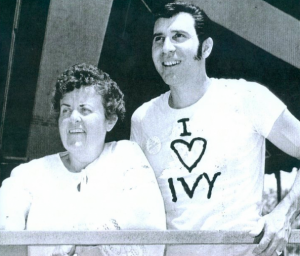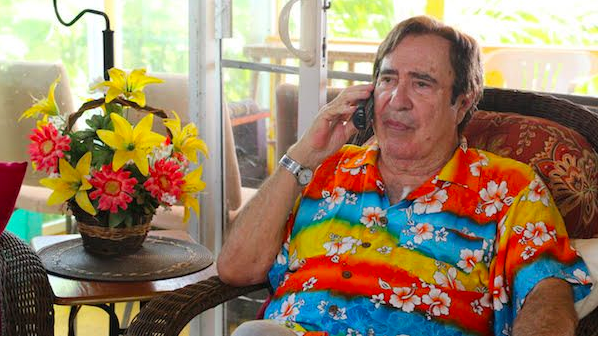
Pat Rocco, the iconic maker of erotic gay films and chronicler on film of historically significant LGBT parades, festivals and demonstrations, has died.
Rocco, 84, had suffered from a heart condition according to his longtime partner, David Kirk Ghee.
Rocco is known as one the co-organizers of the first L.A. Pride Parade in 1970 and for coming up with the idea in 1974 for the annual Pride Festival, events that over the years has attracted hundreds of thousands of people to West Hollywood. The first parade took place on Hollywood Boulevard. The first festival was a carnival with rides, games, food and information booths held in a parking lot at Sunset Boulevard and Cherokee. Because of hostility from the Los Angeles Police Department and development in Hollywood, Christopher Street West, the non-profit producer of the annual Pride parade and festival, moved both of events in 1979 to what would become five years later the City of West Hollywood.

Rocco and Ghee moved recently to Mount Baldy, an unincorporated community in the San Gabriel Mountains, where Rocco had owned a cabin in the mid-1950s. That mountain cabin became a gathering spot for gay liberation pioneer Morris Kight and other members of Christopher Street West as well as for members of the then Gay and Lesbian Community Center, the Radical Fairies (with Harry Hay), the Hudson House (a shelter for the LGBT homeless), the Society of Pat Rocco Enlightened Enthusiasts (SPREE), a gay theatre and film club formed by Rocco’s fans, and other LGBT groups.
“The Cabin, as it was affectionately known, was the place where friends and organization members could enjoy complete privacy in a lush mountain setting (that also included a cool running stream that often turned into a clothes-optional experience, and much more than that, if you know what I mean,” Rocco said in an essay for GayLifeLA.com.
“These outings were often used to discuss the good and bad about numerous organizations and how to improve on them, in a relaxed setting for everyone, and also to enjoy the camaraderie of like-minded men and women who were trying to improve and expand experiences of being gay.”
Rocco was born in Brooklyn, N.Y., to a large Italian family and lived there until the age of 11 when his father, a draftsman, moved to California. He graduated from Monrovia-Arcadia-Duarte High School and attended college for a year.
“During that time there’d been another talent that had been growing that I guess had started when I was really very young, and that was singing.,” Rocco said in a 1983 interview with Jim Kepner for the ONE National Gay & Lesbian Archives. “And I loved to sing, I just enjoyed it. Music was a big thing with me. And when television started coming in in like ’46, ’47, ’48, I saw this as a field that I wanted to get into somehow. And so I got on …

“And then in the late ‘50s I got on the Tennessee Ernie Ford show and was a regular on that for three years. And that’s when NBC went color at just that time…song and dance, not too much dance, fortunately, because I’m not a professional dancer…”
In his youth Rocco briefly ran Bizarre Bazaar on Selma Avenue in Hollywood, which he described in his interview with Kepner as “the first head shop in Hollywood, so-called head shop, posters, paraphernalia. We served a thing called LSD coffee. We sold the underground newspapers. We showed midnight movies.”
It was while reading a newspaper in Bizarre Bazaar that Rocco discovered a classified ad soliciting a photographer to shoot “male nude studies.”
“I had dabbled in photography all my life,” Rocco said in his interview. I’d always loved to take a camera around with me and I’d dabbled sometimes with little movie cameras too, and I had made home movies of stuff, and I was interested in photography always. And so I decided to answer the ad.”
Rocco was hired and over time produced other short clips of nude men that he advertised for sale. The response was overwhelming, prompting him to create a 40-page catalog to promote the videos and close down Bizarre Bazaar. Soon he was contacted by the owner of the Park Theatre on Alvarado Street who asked him to make films for him. In 1968, the theatre advertised and screened Rocco’s “Love Is Blue” and “Fanny’s Hill” in what it called “A Most Unusual Film Festival,” which was the first public screening of gay erotica in America.
Rocco produced dozens of gay erotic films, some of which out-grossed mainstream films when they were screened at the few theatres that would show them. By 1972 Rocco stopped making such films as the people focused more on hardcore pornographic films. Instead he worked on documentaries. Links to information about the gay erotic films made by Rocco can be found online here and here.
It nearly one year after the Stonewall riots of June 1969, when Rocco collaborated with Reverend Bob Humphries (United States Mission founder), Morris Kight (Gay Liberation Front founder), and Reverend Troy Perry (Universal Fellowship of Metropolitan Community Churches founder) to plan a parade down Hollywood Boulevard to commemorate the riots. Securing a permit from the City of Los Angeles wasn’t easy. Rev. Perry has recalled the L.A. Police Chief Edward Davis telling him, “As far as I’m concerned, granting a permit to a group of homosexuals to parade down Hollywood Boulevard would be the same as giving a permit to a group of thieves and robbers.”
The Police Commission finally granted the permit, with fees exceeding $1.5 million. After the American Civil Liberties Union stepped in, the commission dropped all its requirements but a $1,500 fee for police service. That, too, was dismissed when the California Superior Court ordered the police to provide protection as they would for any other group.
All that negotiation left the team with only two days to throw together a parade before the June 28 anniversary. The July 28 parade, organized over two days, included a float from the Advocate magazine on which there were men in swimsuits as well as a conservative gay group in business suits. It became the model for Pride celebrations across the nation.

As an activist, Rocco served on the boards of number of LGBT organizations. For two years Rocco served as director and manager of Hudson House, located on Franklin Place in Hollywood, which shelter for LGBT people in need of housing. He an Ghee moved in 1983 to Hawaii, to open a combination movie theater, restaurant and store.
Ghee, who recalls first meeting Rocco at the old Jaguar gay bar at 7511 Santa Monica Blvd. in the early 1970s, says they moved back to Los Angeles around 1985 then back to Hawaii in 1990. Then in August of last year Rocco and Ghee moved to Palm Springs. “That was supposed to be permanent,” Ghee said. But “Pat didn’t like it because it was too hot.” Rocco and Ghee then returned to the cabin in Mount Baldy where they had hosted friends, many of whom were the early leaders of America’s LGBT rights movement.
Ghee said no plans have yet been made for a funeral or memorial service for Rocco. GayLifeLA will publish those plans when they become available.

My condolences to David, Pat is survived by a wonderful man who i hope can find a new and rewarding path, best of luck my friend.